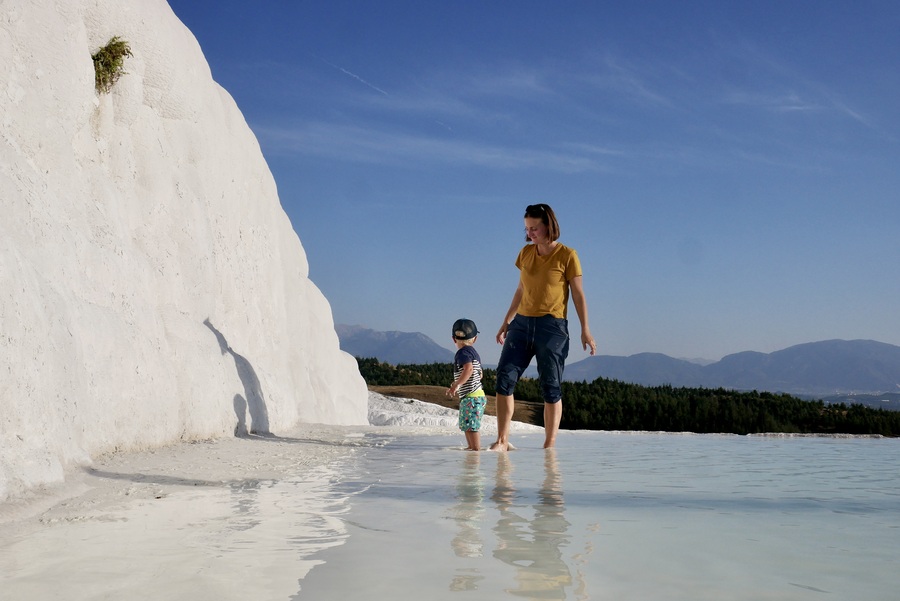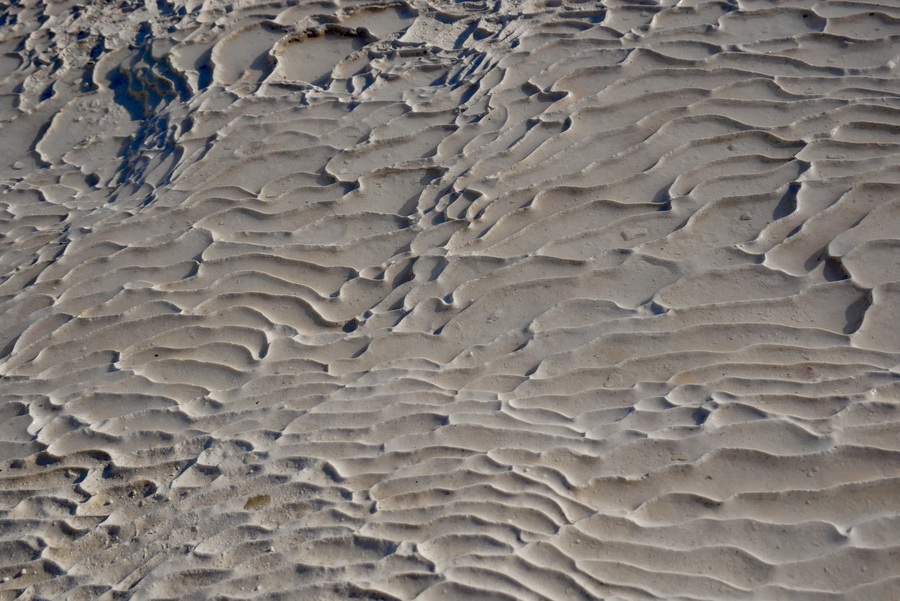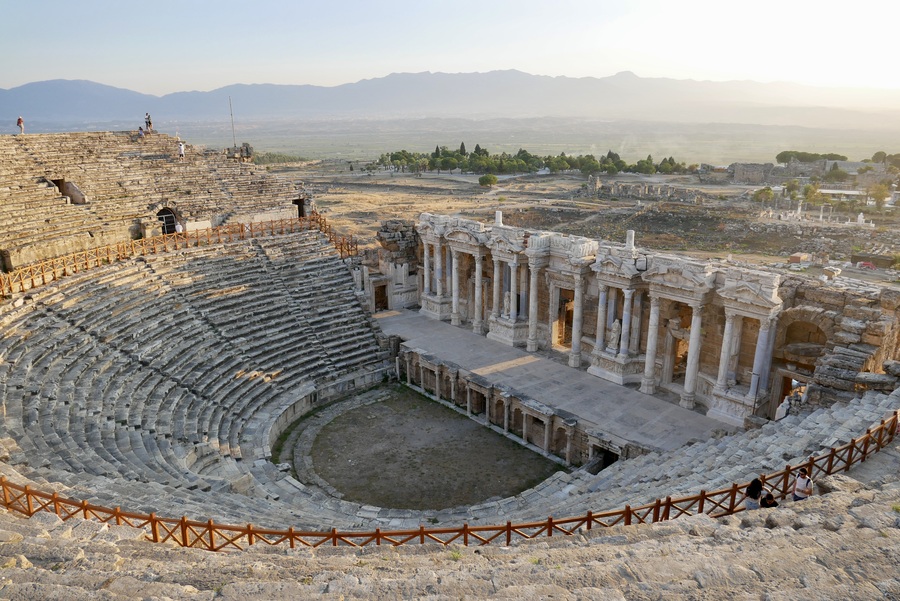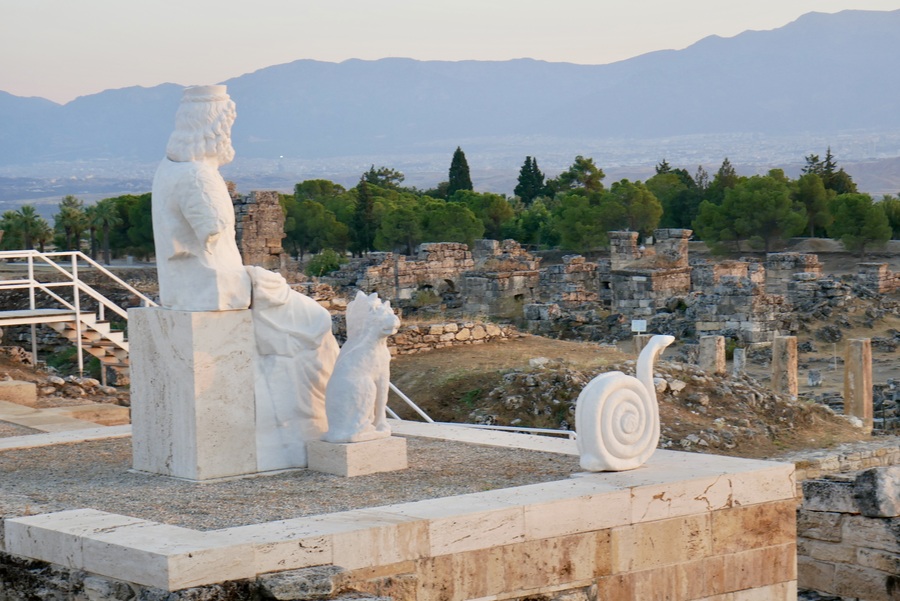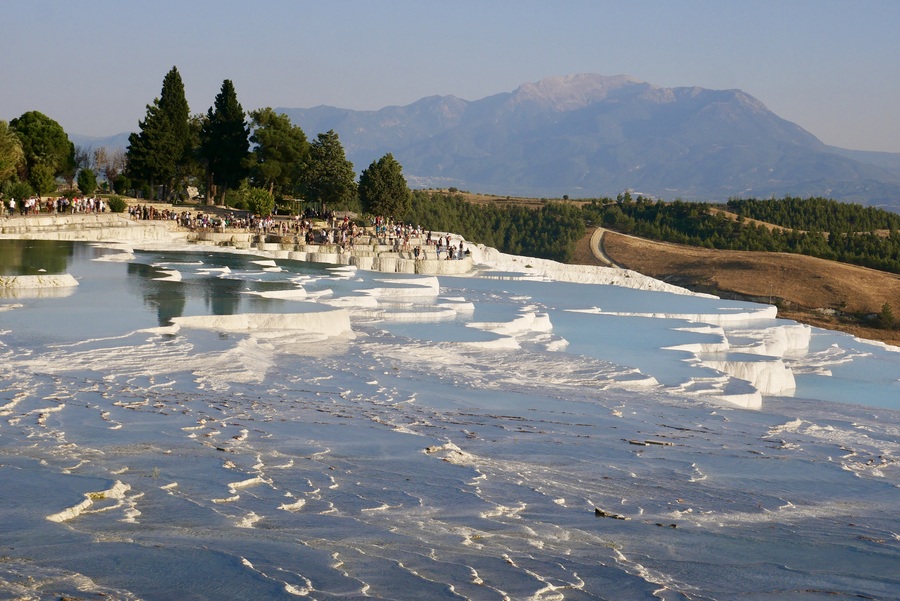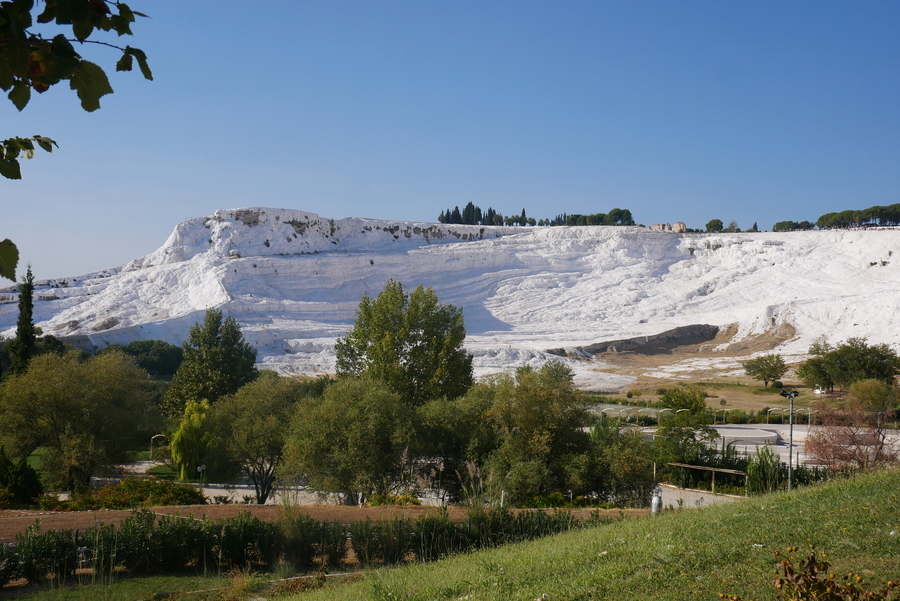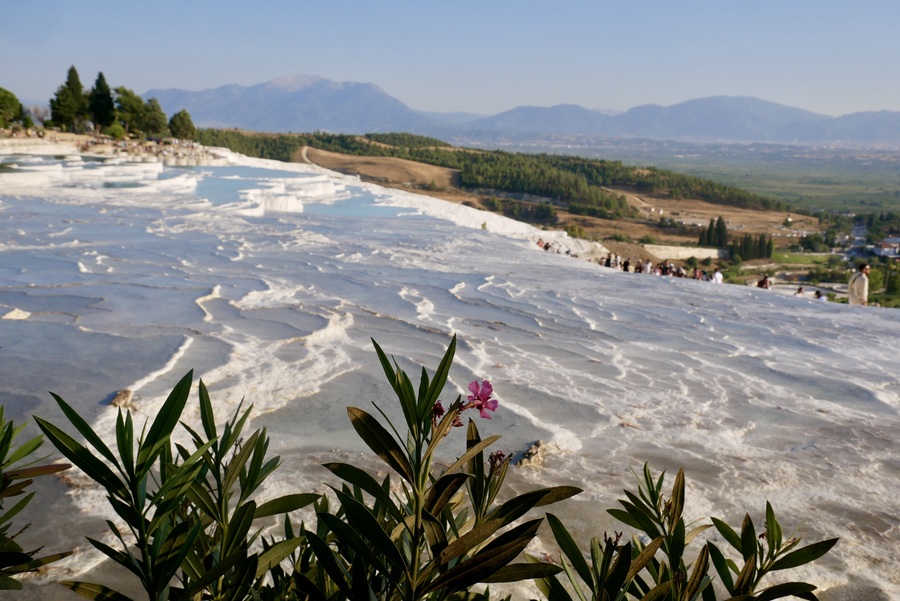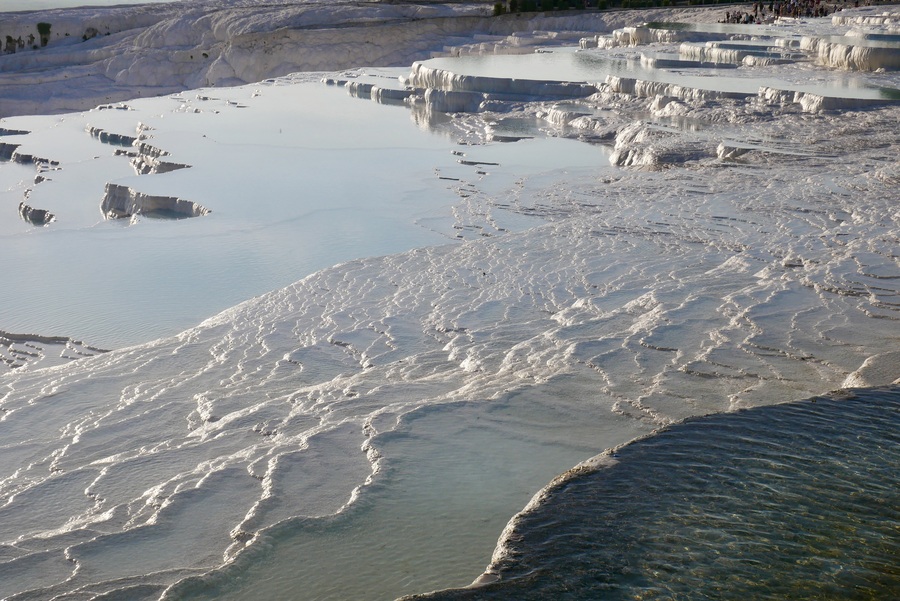
Visiting Pamukkale in Turkey
Imagine glistening, chalk-white terraces cascading down a hillside. Pools of ice-blue water that reflect the Anatolian sunset. Ancient ruins overlooking thermal waters that have been used for centuries. These are the travertines of Pamukkale, Turkey—one of the most popular tourist attractions in the Middle East.
You’ve likely seen pictures of these natural wonders: a breathtaking blend of nature’s beauty and human ingenuity.
But, as with every destination that skyrockets in popularity, discussions have now turned to Pamukkale being overrated and overhyped. Are the glistening travertines as beautiful as social media promises? Is Pamukkale worth going out of your way to see?
Pamukkale Turkey: The Cotton Castle
Pamukkale means “cotton castle” in Turkish. The geological formation consists of a series of white terraced pools that tumble down a hillside.
These gleaming white calcite terraces, filled with warm mineral-rich waters, have been revered throughout history, from the Roman period until today.
Just above the terraces lies Hierapolis, once a Roman and Byzantine spa city, which has ancient ruins that include a beautifully preserved amphitheater.
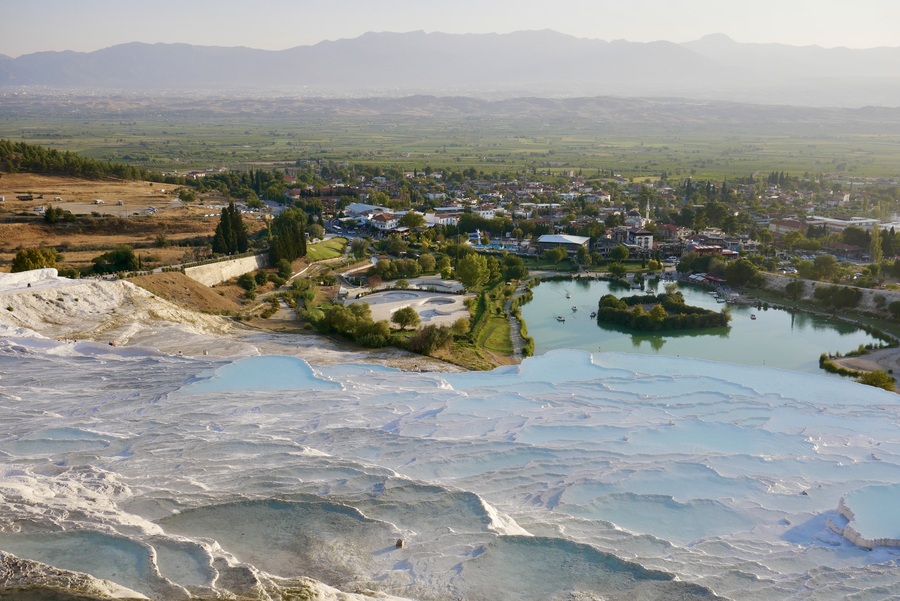
In the present day, Pamukkale is an UNESCO World Heritage site. You can visit both its ruins and thermal pools on a single ticket.
It is one of the most visited destinations in Turkey, alongside Istanbul and Cappadocia.
The Travertines of Pamukkale Turkey
As calcium carbonate-saturated water reaches the surface, carbon dioxide escapes, leaving behind soft calcium carbonate that eventually crystallizes into travertine.
Pamukkale’s current hydrothermal system and mineral formations were likely established following the Laodikeia earthquake in the seventh century.
Hieropolis Ruins in Pamukkale
For many travelers, the Hieropolis ruins are a secondary reason for visiting Pamukkale.
Situated just above the terraces, these ruins are some of the best-preserved in Turkey. While Ephesus might hold the title for grandeur, Hierapolis should not be overlooked.

Founded as a thermal spa in 190 BC, the city was likely named for Hiero, wife of the founder of the Pergamon Kingdom.
-
The Ancient Roman Theater
The ancient theater is the centerpiece of the Hieropolis ruins. The theatre dates back to the second century AD under Roman Emperor Hadrian. It was later renovated under Septimus Severus and adorned with elaborate limestone and marble carvings. The ancient theater at Pamukkale contains one of Anatolia’s most complete and best-preserved collection of Greco-Roman theatre decorations.
At its peak, the Hieropolis theater would have had a seating capacity of over 10,000 people.
Excavation of the theater began in 1957 by a group of Italian archaeologists. By 1988, the Hierapolis gained recognition as a UNESCO World Heritage Site. From 2009-2013, the Italian Archaeological Mission undertook an extensive restoration of the theater, with funding from the Turkish Ministry of Culture.
-
The Necropolis
The Hieropolis Necropolis is one of the largest ancient cemeteries in Anatolia. It contains over 1,2000 tombs with a wide variety of burial types—including sarcophagi, stone graves, and mausoleums reflecting different cultural influences over the centuries.
-
Plutonian Devil’s Gate
A sacred cave, once believed to be a gateway to the underworld, lies next to the Temple of Apollo. This ancient site was dedicated to the Roman god Pluto, the god of the underworld. The Plutonium was considered a gateway to the underworld due to the presence of toxic gases that surfaced from a deep chasm.
The Plutonium’s entrance has been sealed for safety, but the hissing of deadly gases is still audible.
-
Cleopatra’s Antique Pool
The Antique Pool, often referred to as Cleopatra’s Pool, is a unique attraction within the ruins of Hierapolis. This ancient swimming pool is filled with thermal waters and adorned with submerged ancient columns and marble fragments. Legend has it that Cleopatra herself swam in the pool’s healing waters.
The pool is open from 8am to 5pm and entrance to the pool requires an additional fee. We didn’t have time for a proper soak during our visit to Pamukkale, so we decided to forego the experience altogether.
-
Pamukkale Archaeology Museum
Housed in former Roman baths, the Pamukkale Archaeology Museum showcases spectacular sarcophagi from Hieropolis and the nearby archaeological site of Laodicea.
Ticket prices for Pamukkale and the Hieropolis include museum entry.
Does Pamukkale Live Up to the Hype?
The photos I have taken of Pamukkale are 100% unfiltered and unedited.
That being said, it is worth noting that there are only certain sections of Pamukkale that look the way they do in my pictures. Before my visit, I’d heard a lot of mixed reviews surrounding Pamukkale . A friend of mine had called Pamukkale one of the most disappointing destinations in all her travels. Online, I saw plenty of debates about expectations vs. reality.
Once upon a time, the calcium-rich water used to pour freely over all the travertines. However, those photos of hundreds of blue water pools that tumble down the cloud-like fortress of calcite, were from decades ago.
In recent years, much of Pamukkale’s water has been diverted to help sustain the growing population of nearby towns.
Now, the crystal pools only cover a small section of the cotton castle.
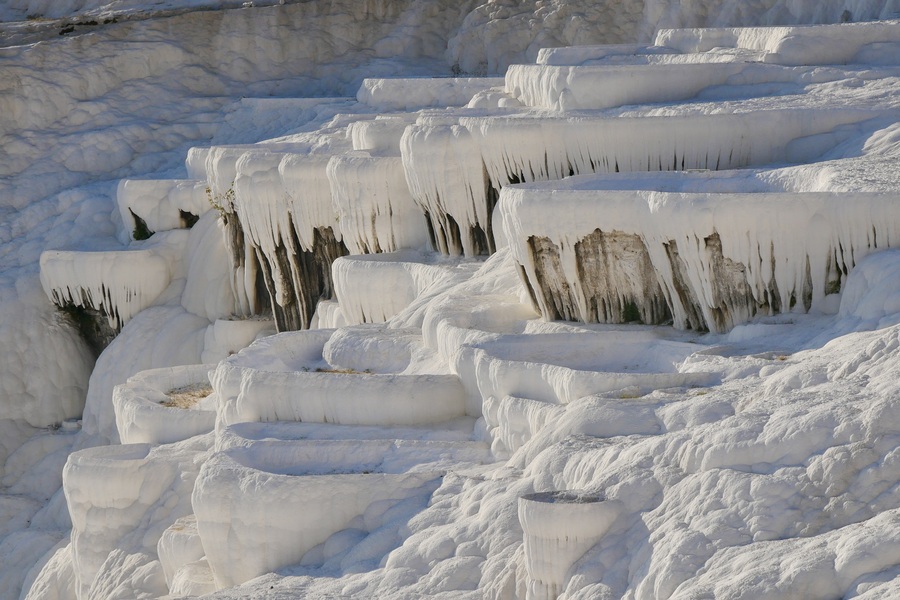
So does Pamukkale live up to the hype? Or is it yet another place that has been ravaged by tourism and overdevelopment.
My verdict is this: Pamukkale is a beautiful place to visit, as long as you manage your expectations. The site is still beautiful, just not as pristine as the social media images suggest.
Where to Stay in Pamukkale Turkey
Most visitors to Pamukkale stay in Denizli, unless visiting on a day trip. We stayed at the simple but convenient Mustafa Hotel in Denizli for one night during our visit to Pamukkale. The hotel was conveniently located, affordably priced, and fit our needs since all we wanted was a place to rest our heads. It had a nice view of the travertines, but was nothing fancy.
If you’re looking for more comfort, the Pamukkale Sahin Boutique Hotel (midrange) or the Pamukkale Whitehaven Suite Hotel (high-end) offer better options.
Pamukkale Tours
Pamukkale Turkey is easy to visit independently, but there are plenty of guided tour options for travelers who want to avoid the logistics of DIY travel. You can join guided day trips of the archaeological site from nearby towns, or multi-day group excursions from Turkey’s major cities.
Hot air balloon tours above Pamukkale provide a different vantage point of the UNESCO site. We chose to forego a Pamukkale hot air balloon ride since we had already done a balloon tour in Cappadocia a few days prior.
Best Time to Visit Pamukkale Turkey
Spring and Fall are the best times to visit Pamukkale. The shoulder seasons bring thinner crowds and cooler temperatures. Summer in Central Turkey can be scorching hot and crowded, while winter often sees snow.
Pamukkale Sunrise
In Pamukkale, sunrise brings pastel hues, fewer tourists, and a smattering of hot air balloons above the travertines.
The south entrance of Pamukkale opens at 6:30am, while the north entrance opens at 8am. By getting up early, you can avoid most large tour groups and enjoy the Cotton Castle in relative quiet.
I’ve read in a few places, however, that the pools tend to be emptier in the morning since water gets pumped into the site throughout the day.
Pamukkale Sunset
We chose to visit Pamukkale at sunset—partly because that is what worked best for our schedule, and partly because we wanted to see the sky’s colors reflected on the calcite pools.
Sunset has the best lighting for photography in Pamukkale , as the sun sets directly across from the pools.
Unfortunately, sunset also tends to be when Pamukkale is at its most crowded, since water levels and lighting converge to create the optimal viewing experience.
****
I’m thankful to have visited many destinations around the world before they were “discovered” by mass tourism.
Unfortunately, I got to Pamukkale too late for the party.
Pamukkale is one of Turkey’s most famous tourist destinations. Thousands of people flock to the Cotton Castle annually in order to soak in the picturesque calcite pools.
As a result of overtourism in Pamukkale, the area doesn’t quite look like it used to.
But I still think that, long as you adjust your expectations, Pamukkale remains an unforgettable place to visit.



